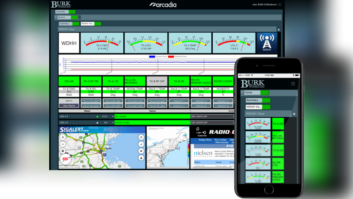An Antenna Like the SWR Illumitron-HD, the Author Believes, Can Resolve Most FM IBOC Signal and Coverage Problems, ‘Perhaps Better Than the Proposed 10 dB Increase in Digital Power’
With great appreciation to Leslie Stimson, Bert Goldman, Marty Hadfield and other contributors for their recent excellent article (Aug. 1) updating the proposed power increase for the digital portion of FM IBOC signal format, I fully support the need for caution and further research before such a step is approved, for these reasons:
- Tests documented at present show results with only the “test signal” increased by 10 dB, with all co-channel and adjacent digital signals remaining at –20 dB, or often as “analog only” stations. It is reasonable to assume that much of the observed coverage improvement will vanish when all co- and adjacent signals are IBOC running at the higher digital power level. Additional tests are needed.
- Similarly, interference to “analog only” stations was observed when only one station made the proposed digital power increase. What happens when several co-channel and adjacent stations make the same digital power increase? Again, more tests are needed.
- The proposed digital power increase assumes that most digital reception problems are due to insufficient power in the digital portion of the IBOC signal. In reality, the increased digital power tends to mask the symptoms; however, it does not resolve the underlying cause of the reception problems. If all co-channel and adjacent stations make the same increase, these symptoms may return.
- I have devoted much of my 50-year career to the field of FM signal propagation, coverage improvement and antenna system design. As in the case of analog FM radio, field intensity measurements on most stations disclose large variations in signal strength (often +/- 10 dB) over distances of 10 feet or less. (The primary cause of this problem is multipath, often the product of a transmitting antenna with multiple lobes and nulls in the elevation pattern.) As a result, an analog FM signal will have a “picket fence” effect from noise or interfering signals at each low point in signal level, even though average signal strength may be 60 or 70 dBu. An IBOC digital signal may suffer similar problems from wide signal strength variations, in addition to severe changes in digital to analog ratio.
- I have resolved these problems for many FM stations through use of a single-lobe antenna designed to minimize multipath and resulting field intensity variations. Many of these stations report a signal quality and coverage improvement similar to that of a power increase of approximately 8 dB, although no increase in average power or field intensity is observed. (Please note that FM receivers respond to minimum signal level, rather than average or predicted value.)
- In view of the above, it is logical that a single-lobe FM antenna, such as the SWR Illumitron-HD, can resolve most FM IBOC signal and coverage problems, perhaps better than the proposed 10 dB increase in digital power level, and without the huge costs and logistics problems of the increase.
This method has additional benefits, including increased analog coverage and reduced interference to all co-channel and adjacent channel stations. (We should remember that more than half of all FM stations are analog only, and reducing interference to them is very good PR for all of us!)
Elevation pattern of SWR Illumitron, below, and a traditional FM antenna

Lee Granlund
Sacramento, Calif.












